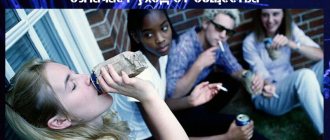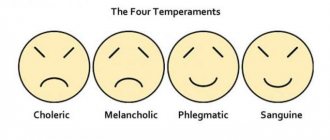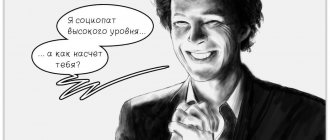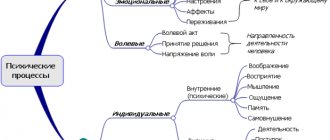- KtoNaNovenkogo
- FAQ
- Are you here
February 17, 2020
- What it is
- Types of deviant behavior (examples)
- How to recognize a deviant
- Causes of deviation
- Correction of deviant behavior
Hello, dear readers of the KtoNaNovenkogo.ru blog. There are a lot of borrowed words in the Russian language that are often used, but their meaning is not always clear from the context (for example, carsharing or showroom).
Today I just want to devote an article to another borrowed term - deviation. We'll talk about what it is and where it's used. After which we will dwell in detail on its use in sociology, namely on deviant behavior, its examples and those who are identified as deviants in society.
Reasons for deviant behavior
In adolescents, the causes of deviation are social, these are shortcomings in upbringing. From 25% to 75% of children come from single-parent families, 65% of teenagers have serious character disorders, 65% have accentuates. Sick patients with delinquent deviations up to 40%. Half of them have a condition called psychopathy. Vagrancy and running away from home are in most cases explained by delinquency. The very first escapes are carried out out of fear of punishment or act as a reaction of protest, and then turn into a conditioned reflex stereotype.
The reasons for deviant delinquent behavior of adolescents lie in insufficient supervision, lack of attention from loved ones, in anxiety and fear of punishment, in fantasy and daydreaming, in the desire to get away from the care of teachers and parents, in cruel treatment from comrades, in an unmotivated desire to change a boring environment. .
Separately, I would like to note the early alcoholism and drug addiction of adolescents. Among delinquent adolescents, most are familiar with drugs and abuse alcohol. The motives for such use are the desire to be in the company of others and become an adult, to satisfy curiosity or to change one’s mental state. In subsequent times, they take drugs and drink for a cheerful mood, as well as for self-confidence and relaxedness. The emergence of a group addiction to getting drunk at a meeting of friends carries the threat of alcoholism. And a teenager’s desire for drug use is an early sign of drug addiction.
Signs of deviant behavior
Deviant behavior is defined by deviant characteristics that do not correspond to officially established as well as generally accepted social norms. Non-normative behavior causes negative evaluation in people. Deviant behavior has a destructive or self-destructive orientation, which is characterized by persistent repeated or long-term repetition.
Signs of deviant behavior: social maladjustment, age, gender and individual uniqueness. It is very important to differentiate deviant behavior (illegal and immoral) from oddities, eccentricities, eccentricities, existing individuality that does not cause harm.
Examples
As positive deviations, we can cite the story of the brilliant physicist Albert Einstein. This man was so helpless in everyday life that it is impossible to imagine how he managed to develop such advanced ideas. Everyone will say that Einstein devoted himself completely to what he loved, so much so that he had no opportunity to learn anything in everyday life. There will also be those who object. After all, many talented and even brilliant people coped quite well with cooking dinner or cleaning rooms.
Other examples are Salvador Dali, Van Gogh. Their life also did not become an example of the threat of undermining social foundations. But the very way of life, significantly different from the bulk of people in this society, speaks of deviant behavior. These people have lost the opportunity to embody the expected standards; the culture of their activities in society is rather disorganized.
Currently reading: Anger management - 5 effective techniques
Deviant behavior of adolescents
Currently, the number of children who consider the goal of life to achieve material well-being has increased, and they strive for this at any cost. Study and work lost their social significance and value and began to have a pragmatic character. Teenagers strive to receive as many privileges and benefits as possible, study less, and also work. This position of young people takes on militant and open forms over time, giving birth to new consumerism, which often provokes behavioral deviations. Deviant behavior of adolescents is determined and aggravated by the economic situation in the country. This is evidenced by the increase in the level of juvenile crime, where property is often the object of the crime.
Deviant behavior of adolescents is marked by a characteristic orientation towards material and personal well-being, as well as towards life according to the principle “how I want”, asserting oneself by any means and at any cost. In most cases, young people are not driven by the desire to satisfy needs and self-interest through criminal means, but are attracted to participate in the company in order to be considered brave. Adolescent deviations are a common phenomenon that is accompanied by the process of maturity and socialization, increasing throughout adolescence and decreasing after 18 years.
Deviations are often not recognized by children, and the opportunity to resist the negative influence of the environment arises after the age of 18 and later. Deviant behavior of adolescents is a complex phenomenon, and the study of this problem is diverse and interdisciplinary. Often, some children draw attention to violations of the norms and regulatory requirements of the school, family, and society.
Deviant behavior of adolescents includes antisocial, anti-disciplinary, delinquent, illegal, as well as auto-aggressive (self-harm and suicidal) actions. Actions are determined by various deviations in personality development. Often these deviations include children's reactions to difficult life circumstances. This condition is often borderline (the border between disease and normal). Therefore, it should be assessed by a teacher and a doctor.
The causes of adolescent deviation are associated with the conditions of upbringing, characteristics of physical development and social environment. A teenager, assessing his body, states the norm, physical superiority or inferiority, making a conclusion about his social significance and value. The child may develop either a passive attitude towards his physical weakness, or a desire to compensate for deficiencies, or he will try to eliminate them through physical exercise. Sometimes a delay in the formation of the neuromuscular system disrupts the coordination of movements, which manifests itself in clumsiness.
Reproaches and hints from others regarding appearance, as well as awkwardness, provoke violent emotions and distort behavior. Tall boys are confident in their strength and masculinity. There is no need for them to fight for the respect of others. Thanks to their confidence, other children perceive them as very intelligent. Their behavior is more docile, natural and needs less attention. Thin, developmentally delayed, short boys appear to others as immature, small and unadapted. They need care because they are rebellious. In order to change an unfavorable opinion about them, one must show enterprise, ingenuity, courage and be constantly in sight, and through personal achievements prove their usefulness, as well as indispensability to the group they belong to. This activity provokes emotional tension and communication difficulties, which creates all the conditions for violations of generally accepted standards.
Puberty plays an important role in behavior. Premature sexual development in some people manifests itself in emotional disorders, in others it provokes behavioral disturbances (hot temper, pretentiousness, aggressiveness), and disorders of desires arise, in particular sexual ones. When sexual development is delayed, lack of composure, slowness, uncertainty, difficulties in adaptation, and impulsiveness occur. The emergence of deviant behavior is determined by psychological characteristics.
Features of deviant behavior in younger adolescents include disproportions in the pace and levels of personality development. The emerging feeling of adulthood provokes an inflated level of aspirations, unstable emotionality, and is characterized by fluctuations in mood, as well as rapid switching from exaltation to decreased mood. When a younger teenager encounters misunderstanding in his aspirations for independence, outbursts of affect arise. A similar reaction occurs to criticism of external data or physical abilities.
Features of deviant behavior of adolescents are noted in unstable mood in boys at 11-13 years old, and in girls at 13-15 years old. This age shows marked stubbornness. Older children are interested in the right to independence, as they are looking for their place in this life. There is a division of interests and abilities, psychosexual orientation is determined, and a worldview is developed. Often, determination and perseverance coexist with instability and impulsiveness. Excessive self-confidence of adolescents and categoricalness are combined with lack of self-confidence. The desire for extended contacts is combined with the desire for loneliness, arrogance with shyness, romanticism with cynicism and pragmatism, and the need for tenderness with sadism. The development of a teenager's personality is influenced by society and culture and is directly related to economic status, as well as gender.
Theories
Based on the leading causes of deviations from social norms, various theories of deviant behavior have been created.
Biological theories
The bottom line: deviant actions are a consequence of innate inclinations. Such people cannot restrain their base needs and do everything to satisfy them, regardless of the rules and even the fear of punishment.
Lombroso
The theory of the innate criminal of the Italian psychiatrist, teacher and psychologist Cesare Lombroso is biological. Based on the results of many years of work in prisons, the scientist concluded that the deviant actions of 1/3 of all criminals are due to qualities inherent in nature itself. They all differ in a set of the same characteristics:
- stubborn in their malice and ferocity;
- underdeveloped;
- unable to curb their instincts;
- not amenable to correction;
- having a specific appearance: a disordered jaw, a flat nose pressed into the face, a sparse beard, long arms.
Lombroso compared them to monkeys. But the British doctor Charles Goring criticized his theory and substantiated its inconsistency.
Sheldon
The constitutional theory of temperament of the American psychologist William Herbert Sheldon also belongs to the biological ones. In his opinion, a person’s actions can be predicted by his body type:
- endomorphs (moderately overweight) are sociable and know how to get along with others;
- mesomorphs (strength and slimness) are restless, active, insensitive to pain and most prone to deviant behavior;
- ectomorphs (fragile body) are prone to introspection, have increased sensitivity and nervousness.
However, Sheldon's theory doesn't always work. Among criminals and other persons with deviant behavior there are people with different body types.
Gove
Another biological theory based on the influence of gender and age characteristics. Author: Walter Gove. Conclusions from the research:
- Most often, deviant actions are observed among young people, the peak occurs at 18-24 years old;
- in second place are teenagers 13-17 years old;
- on the third - 25-30 years;
- and only then comes the age after 30 years, when crimes are committed either in a state of passion or as a result of serious mental disorders.
There is also scattered evidence from individual studies suggesting that the tendency to deviate may be due to genetics:
- twins with the same number of chromosomes in 50% of cases commit the same violations of norms separately from each other, without agreement;
- Adopted children with their deviations are similar to biological, not adoptive parents;
- men with an additional chromosome Y are characterized by severe psychopathic behavior, low intelligence and increased deviation.
Most psychologists do not accept biological theories. The only thing they agree on is that the type of nervous system can play a certain role in deviant behavior, but it is far from decisive.
Social psychological theories
The bottom line: society itself provokes a person to violate its own rules.
Durkheim
Durkheim's famous theory of anomie. In his opinion, during crises, wars, revolutions, coups, changes in power and other social changes, people are in a state of confusion and disorganization and lose their bearings. This makes them behave inappropriately.
Merton
The theory of personality adaptation to the surrounding conditions of the American sociologist Robert Merton expands on Durkheim's anomie. According to it, deviation is influenced not only by social crises, but, first of all, by a person’s reaction to them. This classification is presented below.
Becker
One of the most famous social psychological theories is the theory of labels or stigma. The author is American economist Gary Stanley Becker. He described the process of labeling by the powerful sections of society - the lower ones. Traditionally, gypsies, homeless people, drug addicts, and alcoholics are classified as deviants. But this is unfair, because among them there may be people who adhere to general rules and do not break the law. However, the label of an antisocial, dysfunctional layer of society makes them ultimately behave like deviants.
Psychological theories
The bottom line: the main causes of deviant behavior lie in the psyche.
Existential-humanistic
Representatives of this theory believed that the main reason for deviant behavior is the individual’s disappointment in himself. Each of them focuses on certain aspects of this process.
Austrian psychiatrist, psychologist and neurologist Viktor Frankl considered the suppression of spirituality and loss of meaning in life as a provoking factor.
According to the American psychologist, author of client-centered psychotherapy Carl Rogers, a person’s distorted ideas about himself, low self-esteem, and a tendency to self-deprecation are to blame.
American psychologist, founder of humanistic psychology Abraham Maslow called the frustration of basic needs the main reasons.
Psychodynamic
It is based on Freud's psychoanalysis. The main source of deviant behavior is the conflict between the unconscious and the conscious. Moreover, the former are based on sexual desires. True, neo-Freudians no longer focus on it and give priority to the lack of emotional contact, most often the lack of close communication with the mother.
Behavioral
Classical behaviorism considers deviant actions as a result of the influence of the environment on the individual. In their opinion, if a child is initially punished severely enough for misdeeds, in the future fear will stop him from committing them. Behaviorists pay much attention to methods for correcting deviations, which include negative reinforcement, emotional-negative conditioning and operant response extinction.
Cognitive
According to the theory of American psychotherapist, professor of psychiatry and creator of cognitive psychotherapy Aaron Beck and American psychologist, cognitive therapist, author of rational-emotive behavior therapy Albert Ellis, the causes of deviant behavior are in maladaptive thought patterns that trigger inappropriate feelings and actions.
Forms of deviant behavior
Forms of abnormality in adolescents include hyperkinetic disorder, unsocialization disorder; conduct disorder limited to family; socialization disorder; delinquent disorder.
Characteristics of deviant behavior in adolescents with hyperkinetic disorder include lack of persistence, where mental effort is required, and the tendency to switch from one activity to another leads to not completing any task. The child is characterized by impulsiveness, recklessness, a tendency to get into accidents, and also to receive disciplinary sanctions. Relationships with adults are marked by a lack of distance. Children experience behavior disorder and low self-esteem.
Conduct disorder limited to the family includes antisocial as well as aggressive behavior (rude, protesting), which manifests itself at home in personal relationships with relatives. There is theft, destruction of things, cruelty, and house arson.
Unsocialization disorder is marked by a combination of antisocial as well as aggressive behavior. The disorder is characterized by a lack of productive communication with peers, as well as manifestations of isolation from them, rejection of friends and empathic mutual relationships with peers. Teenagers show cruelty, disagreement, and indignation with adults; they are much less likely to have good relationships, but without trust. Concomitant emotional disorders may occur. Often the child is lonely. This disorder is marked by extortion, pugnaciousness, hooliganism or violent attacks, as well as cruelty, rudeness, disobedience, resistance to authority and individualism, uncontrollable rage and severe outbursts of anger, arson, destructive actions.
Socialization disorder is marked by persistent asociality (deceit, leaving home, theft, truancy from school, extortion, rudeness) or persistent aggression that occurs in sociable adolescents and children. They often belong to a group of antisocial peers, but they can also be part of an indifferent company. Such teenagers have very bad relationships with adults representing power. They are characterized by behavioral, mixed and emotional disorders in combination with antisocial, aggressive or defiant reactions with symptoms of anxiety or depression. Some cases have the described disorders in combination with constant depression, expressed in manifestations of severe suffering, loss of pleasure, loss of interests, self-blame and hopelessness. Other disorders manifest themselves in anxiety, timidity, fears, obsessions and worries about one’s health.
Delinquent violation implies misdemeanors, minor offenses that do not have the degree of crime. Deviations are expressed in the form of skipping class, hooliganism, communicating with antisocial companies, bullying the weak and small, extorting money, stealing motorcycles and bicycles. Speculation, fraud, and home theft are common.
Deviation of the behavior of intimate desires acts as a separate form of deviant behavior of adolescents. Teenagers often have a lack of awareness and increased sexual desire. Since sexual identification is not fully completed, for this reason deviations in intimate behavior arise. Adolescents with delayed and accelerated maturation are subject to such changes. Those who are developmentally delayed become objects of seduction by older teenagers.
Deviations of sexual behavior in adolescents often depend on the situation and are transient. These include visionism, exhibitionism, manipulation of the genitals of animals or younger children. As one grows up, deviant behavior disappears, and in unfavorable cases it turns into a bad habit, persisting along with normal sexual behavior. Incoming teenage homosexuality is often determined by the situation. It is typical for closed educational institutions where teenagers of the same sex live.
The next form of deviant behavior of adolescents is expressed in the psychogenic pathological formation of personality. The abnormal formation of an immature personality is carried out under the influence of chronic psychotraumatic situations, ugly upbringing, severe experiences of difficulties, chronic diseases, protracted neuroses, defects of body organs and senses. Behavioral disorders often lead parents and experienced teachers to a dead end.
Correction of deviant behavior of adolescents is carried out by a psychologist, since the educational measures of teachers are not enough. The task of psychologists is to reveal the true causes of deviant behavior, as well as to provide the necessary recommendations.
Correction
Deviation as a social phenomenon and society’s reaction to it is the subject of sociological study. Pedagogy and psychology deal with it as an individual personality trait.
In order for society to survive, to create prosperous conditions of existence, norms of behavior - laws - are established in it. Possible control over their implementation is organized. If cases of deviation are noted, corrective measures are taken depending on the scale of the problem. The main forms of control are:
- prevention of persons at risk (most often schoolchildren);
- isolation of persons who pose a danger to other members of society - hardened criminals, terrorists, extremists;
- isolation and appropriate treatment of persons suffering from mental disorders and various types of addictions (drug dispensary, mental hospital);
- rehabilitation of persons who want and can return to normal life.
Imprisonment is the traditional way of punishing offenders. However, it cannot be called an effective method for correcting deviant behavior. People often become embittered, lose the skills of normal life in society, become withdrawn, join the subculture of prisoners, and acquire criminal interests. Therefore, the statistics are not surprising: 60% of those released within 4 years commit a crime again and end up behind bars.
For younger schoolchildren, the most effective methods of correction are educational conversations and individual work with a psychologist.
Psychotherapeutic techniques are selected for adolescents who have been diagnosed with deviant behavior. Group trainings, role-playing games, the use of visual material (videos, illustrations, audio recordings), art therapy - all this with the active participation of parents can solve this problem. Sometimes medication is prescribed in the form of sedatives.
Classification of deviant behavior
The classification includes various types of deviant behavior: criminogenic level, pre-criminogenic level, pre-deviant syndrome.
Pre-criminogenic level, which does not pose a serious danger to society: violation of moral standards, minor offenses, violation of rules of behavior in public places; use of narcotic, alcoholic and toxic substances; avoidance of socially useful activities.
Crime level, expressed in criminally punishable criminal acts. The core of deviant behavior is crime, drug addiction, suicide, and alcoholism. There is also a pre-deviant syndrome, which includes a complex of symptoms that lead an individual to persistent forms of deviant behavior. Namely: family conflicts, affective type of behavior; aggressive type of behavior; negative attitude towards the educational process, antisocial early forms of behavior, low level of intelligence.
What is deviation: types and examples
Deviation translated from Latin means deviation. In psychology there is such a thing as deviant behavior. If the actions and actions of an individual do not correspond to the norms of behavior established in society, then such a deviation from the rules is a sign of deviation. In any society, people are obliged to behave according to generally accepted rules. Relations between citizens are regulated by laws, traditions, and etiquette. Deviant behavior also includes social phenomena expressed in stable forms of human activity that do not comply with the rules established in society.
Types of deviation:
- delinquent (crime);
- asocial (ignoring rules and traditions);
- self-destructive (bad habits, suicide);
- psychopathological (mental diseases);
- dissocial (abnormal behavior);
- paracharacterological (deviations due to improper upbringing).
Deviation can be positive or negative. If an individual strives to transform life, and his actions are dictated by the desire to qualitatively change the social system, then there is nothing reprehensible in this desire. However, if a person’s actions lead to disorganization of the social environment, and to achieve his goals he uses illegal methods, then this indicates the individual’s inability to socialize and unwillingness to adapt to the requirements of society. Actions that go beyond the law are examples of negative legal deviation.
Social deviation can be both positive and negative. A deviant act in society depends on the motivation that determines it. Manifestation of fearlessness and heroism, scientific innovations, travel and making new geographical discoveries are signs of positive deviation. Positive deviants are: A. Einstein, H. Columbus, Giordano Bruno and others.
Examples of negative and illegal deviant behavior:
- commission of a criminal act;
- alcohol and drug abuse;
- sex for money.
Such negative actions are condemned by society and punished according to the norms of criminal law. However, some types of deviant behavior are so firmly rooted in the life of society that their presence does not surprise anyone. People are critical of negativity, although sometimes they try not to notice the deviating behavior of other members of society.
Examples of negative deviation:
- insults;
- assault;
- fight;
- violation of traditions;
- computer addiction;
- vagrancy;
- gambling;
- suicide;
- loud laughter in public places;
- provocative makeup, clothes, actions.
Most often, deviant behavior occurs in adolescents. They are experiencing the most crucial period of their lives - adolescence. Due to the physiological characteristics of the body and imperfect psychological organization, adolescents are not always able to correctly assess the situation and adequately respond to the problem. Sometimes they are rude to adults, play musical instruments loudly at night, and dress provocatively.
Deviations associated with violations in the field of communication between members of society are called communicative. There are different types of deviations from the norms of correct communication.
Types of communicative deviation:
- Congenital autism (desire for loneliness);
- acquired autism (reluctance to communicate due to stressful situations);
- hyper sociability (desire for constant communication with people);
- phobias (fear of crowds, society, clowns).
The founder of the theory of deviation is the French scientist Emile Durkheim. He introduced the concept of anomie into sociology. With this term, the scientist described a social condition in which the value system decomposes as a result of a deep economic or political crisis. Social disorganization, in which chaos ensues in society, leads to the fact that many individuals cannot decide on the correct guidelines for themselves. During such a period, citizens most often exhibit deviant behavior. Durkheim explained the causes of socially deviant behavior and crime.
He believed that all members of society should behave in solidarity with the established rules of behavior. If an individual's actions are not consistent with generally accepted norms, then his behavior is deviant. However, according to the scientist, society cannot exist without deviations. Even crime is the norm of social life. True, to maintain social solidarity, crime must be punished.










